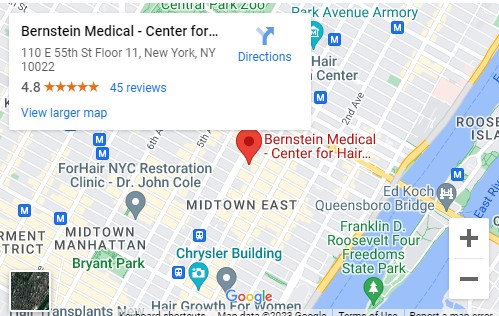Q: Dr. Bernstein, I think that you have established a great monument in the history of hair transplantation. Especially, your historical works about Follicular Unit Transplantation, which you published about 15 years ago, have contributed greatly to the spread of modern hair transplant technique in the whole world.
In the past days, there might have been many physicians who did not care much about the importance of the follicular unit and they have only cut the grafts to size. Now, every hair transplant physician believes the importance of follicular unit, and there is no one who cut the grafts to size ignoring each follicular unit.
However, there are some physicians who shout that a hair transplant procedure can be called FUT only when people use all single FU exclusively, and the procedure cannot be called FUT, if mixture of single FU and double FU are used in a session.
I would like to ask you, if you could accept the usage of combination of single FU and double FU under the name of FUT, as long as the grafts were cut according to each FU and intact FU are used throughout the procedure. Could you accept easing of the very strict definition of FUT, which you published about 15 years ago? Could you agree to use mixture of single FU and double FU under the name of FUT? — N.W., Huntington, N.Y.
A: Thank you for the kind words. In thinking about hair transplantation in general, it is important to consider that a hair restoration procedure spreads hair around and, as a result, the transplanted hair will be less dense than the person’s original hair. Therefore, one would never want grafts larger than the largest original follicular units or the results will not look natural. The artificially large grafts will stand out in relatively thin surroundings. If one were to try to fix this by transplanting the doubled FUs very close together (over one or more sessions) one risks running out of grafts for other areas of the scalp. In other words, you can’t fool mother nature.
For example, if a person has thin hair and has only 1-, 2- and 3-hair units occurring naturally in his scalp, then creating 4-hair grafts (by combining two 2’s or 1’s and 3’s) can result in an unnatural, tufted look. Doubling larger follicular units also necessitates larger wounds to receive the grafts which defeats one of the main advantages of FUT, namely to minimize recipient wounding.
That said, it is not unreasonable to place two 1-hair FUs in a single site (if there are extra 1s from the FU dissection) in order to increase density in an area and to eliminate an extra wound.) We do this for crown hair transplants when we are not doing a hairline and there is no need for 1-hair grafts. However, this is the exception.
Technically speaking, anything other than transplanting individual, naturally occurring follicular units is not FUT. However, a physician should make modifications to the procedure for the specific needs at hand. This is the art of medicine. By understanding and applying the underlying principles of Follicular Unit Transplantation, rather than being limited by its nomenclature, the physician will serve his patient best.
In addition to exploring Hair Restoration Answers to learn more about this topic, visit the Follicular Unit Transplant (FUT) section of our website and read detailed information about the hair transplant evaluation, the hair restoration procedure, follicular unit grafts, the donor area, and more.
- What is Trichophytic Closure After An FUT Hair Transplant?
- What is Graft Compression After a Hair Transplant and Why Does it Occur?
Browse Hair Restoration Answers by topic:
On selecting an option from drop-down list, the page content will refresh and update.




